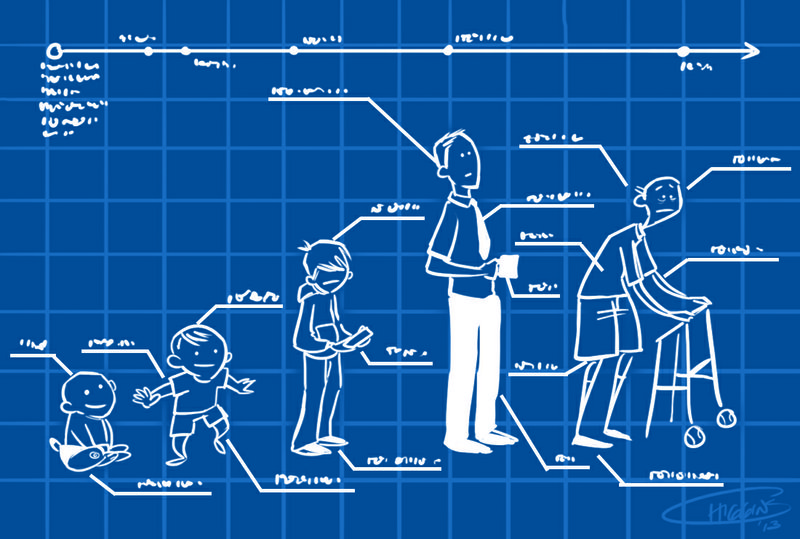How fast are you aging?
Don’t look to online calculators of “biological age” for an answer. Those focus mainly on risk factors for diseases and say little about normal aging, the slow, mysterious process that turns children into codgers.
In fact, scientists are still hunting for biological markers of age that reliably register how fast the process is unfolding. Seemingly obvious candidates won’t do. Wrinkles, for example, often have more to do with sun exposure than aging.
Markers like age-related increases in blood pressure are similarly problematic, often confounded by factors unrelated to aging.
But recently researchers have identified some particularly good indicators of time’s largely hidden toll on our bodies. Developing an “easy way to measure biological age will have a wide array of applications in prediction and prevention of age-related diseases, drug discovery and forensics,” said Dr. Kang Zhang, founding director of the Institute for Genomic Medicine at the University of California, San Diego.
True biomarkers of aging could tell us a lot about our current and future health. Tracking these indexes before and after starting a new diet or exercise program, for instance, might show you whether it was actually pushing off your decline and fall. Aging-rate tests could help scientists evaluate possible anti-aging compounds in humans without prohibitively long studies.
Experts on aging generally agree that acceptable biomarkers of aging should foretell the remaining life span of a middle-aged person more accurately than chronological age does. Further, they should offer a consistent picture of biological age, said Dr. Richard A. Miller, a gerontologist at the University of Michigan: “Do those 50-year-olds with the best retention of immune function also tend to have the least cataracts, good sense of smell, least osteoporosis, lowest blood pressure and best memory?”
Proposed biomarkers of aging haven’t yet convincingly cleared these hurdles, he added. But some provocatively telling ones have come to light.
In a 2010 study, Miller and colleagues analyzed medical records of 4,097 women, collected over two decades beginning when they were in their 60s, to sift out 13 factors that best predicted future mortality from different causes.
Oddly, contrast sensitivity - as measured by a test of the eye’s ability to pick out very lightly shaded images on white backgrounds - was among the most predictive of the 377 factors evaluated, as was the number of rapid stepups on a low platform that the subjects could complete in 10 seconds. Taken together, the 13 factors “characterize the clinical presentation of healthy aging” in older women, the study concluded.
More recently, novel technologies that can detect thousands of age-associated molecular changes in cells have come to the fore in the biomarker hunt.
This year Zhang and his colleagues in San Diego reported that a kind of molecular aging clock is embedded in our genomes whose speed can be measured via blood testing. The moving parts of the clock consist of chemical tags on DNA molecules that control whether genes are active in cells. The researchers found that the patterns of the tags, called epigenetic markers, predictably change with age. In a study published in January in Molecular Cell, the scientists scrutinized about 485,000 of these tags in blood cells of 656 people ages 19 to 101. Some 70,387 tags were predictive of chronological age, the scientists found.
Collectively these tags spell out a “signature for age”that is “largely not changed by disease or ethnic background,” said Ronald Kohanski, an expert on biomarkers of aging at the National Institute on Aging, part of the National Institutes of Health. That means these markers may be less muddied by confounders than other factors tied to aging.
Of the markers, 71 most indicative of chronological age were selected to measure the speed at which people are growing old. That was calculated by comparing a subject’s epigenetic tags to the norm for his age - a 40-year-old whose pattern closely resembled the typical one for 50-year-olds, for example, would apparently be aging 25 percent faster than normal.
Already the molecular clock has yielded interesting findings. Men appear to age on average 4 percent faster than women, the scientists have found, which may largely explain why women’s life expectancy exceeds men’s by about 6 percent worldwide. And the research has shed intriguing light on cancer: The clock indicated that tumor cells have aged, on average, 40 percent more than normal cells taken from the same patients.
“We’re still far from having a diagnostic for biological aging,” said Trey Ideker, the chief of genetics at UCSD and a co-author of the study with Zhang. “But this opens the door to an exciting new approach” to the problem.
If this continuing research pans out, aging-rate tests would someday be standard in annual physicals, and tracking the results over time would offer unprecedented insights on health risks. But such tests also may well raise fractious privacy and social equity issues.
But would insurers demand that customers take them in order to set premiums for life and health-care policies? If such tests revealed how factors like exposure to environmental toxins and the stress of job loss accelerated aging, and by how much, that could be fodder for lawsuits.
Some of us will be relatively short-lived, fast-aging “less fortunate,” and others will be long-lived, slow-aging “more fortunates,” predicted John K. Davis, a philosophy professor at California State University, Fullerton. And age discrimination would gain an entirely new meaning.
ActiveStyle, Pages 23 on 08/12/2013

